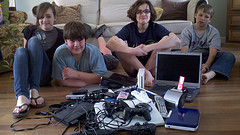
How is your student support team organized? Who is on the team? Are you providing mainly pullout, pull-in, or build-in services? How is your professional development system connected to this team and its mission? There are many questions to ask when we step back and think about the best way to provide reinforcement, enrichment, and an overall differentiated learning environment for our students.
Over the past few years, I have focused on building a systematic approach to developing a curriculum. One aspect of this approach is forming a team approach to build out units of study that incorporate ICL integration, differentiation of instruction and assessment, meeting school-wide goals, etc. Efforts by our learning support team at Alexandria Country Day School and a recent article in the Davidson Journal (Davidson College in NC) reminded me that we should also look at systems supporting student learning outside the curriculum review process.
I remember the early 1990s at the American International School-Riyadh when we developed a student support system for the middle school. The team members included all the teachers, an administrator, the counselor, and the learning support teachers. We created the structure of common meeting times for the two teams at each grade level. One day a week, we discussed individual student learning needs, while on another day, the focus was on the curriculum. We used technology to record learning plans, goals, and results in the student information system. However, the librarian was absent in the meetings while the technology teacher visited to share his lessons and not so much as a collaborator in the curriculum process.
We were ahead of the curve in many ways but failed to make the connection between needing to bring more specialists on board for the curriculum and, just as importantly, for the learning support. The technology teachers and the librarians could have collaborated in both areas to make a difference for our students.
Returning to today, the article from the Davidson Journal explains how the college recently brought different groups of learning support teams together under one roof– the library. As so many of us write about, the library/media center/learning community should be at the center of one’s school/campus. It makes total sense to bring your technology specialists and your other learning support teachers into the library. It also makes sense to have your instructional technologist and teacher librarian as members of your learning support team when creating a curriculum review system and as partners in grade level/department meetings when creating learning support strategies.
An additional item to note is that this team is naturally skilled with “building in” learning support strategies to be added to the units in your curriculum mapping tool. By documenting strategies in your curriculum system to support struggling and students needing enrichment, you move away from the old “pullout” support model.
I learned from Dr. Mary Landrum and my wife’s expertise as a GATE coordinator that the more we can collaborate with teachers to develop learning activities and assessments together, the more that they can pull learning strategies off “the shelf” of the curriculum tool to support students without calling for them to be pulled out of their classes. While Dr. Landrum teaches mainly about providing instruction for gifted students, her book Consultation in Gifted Education: Teachers Working Together to Serve Students provides a collaboration model that can be used to meet the whole spectrum of student needs.
And back to how your professional development program is run, one hopes for teacher involvement in choosing topics and the teaching and learning team adding their insights. This team’s engagement puts them in an excellent position to assess the instructional needs across the school.
I am rambling here, but if you are interested in learning more about Davidson’s new program, I wrote a post for my school’s blog about the Davidson article and how our school was following the same model. Here is that post>
___________________________
Davidson College is known as a very academic liberal arts college that is dedicated to supporting the craft of teaching by its professors. Davidson’s professors do research and write articles and books, but their primary focus is on teaching. To support their efforts, as part of the strategic plan, Davidson opened its Center for Teacher and Learning (CTL) in the school library in August.
The connection to Alexandria Country Day School is that we also opened our Teaching and Learning Center (TLC) in August. What is striking in reading an article from the Fall 2011 Davidson Journal is how similar the two programs are. It demonstrates the forward-thinking and student-centered nature of our administrators and TLC staff when we mirror the program of a college such as Davidson.
Central to the work of our TLC team members is the focus on collaboration with the classroom teachers. This partnership, looking at how best to reach learning goals and meet individual student needs, drives how the TLC teachers help design instruction and provide one-to-one support for our students.
An additional part of this “collaboration team” approach to supporting teaching and learning is the involvement of our instructional technologist, teacher librarian, and director of technology. As part of the iPad pilot program, the fifth-grade teachers worked with our technology and library team members over the summer to review and adapt the fifth-grade curriculum to further support the students in attaining skills for the 21st century. The curriculum was further adapted to meet the information, media, and visual literacy standards supported by the American Association of School Librarians (AASL) and the technology literacies published as the National Educational Technology Standards (NETS) for students. Members of the TLC will join the collaboration team in January as they review the sixth-grade curriculum in preparation for next year and the continued roll “forward” of the iPad Pilot program.
The Davidson Journal article describes the same team effort of the Center for Teaching and Learning – “(the CTL)…brings together these centers- along with the instructional technologists and information literacy librarians- to help students take a comprehensive approach to strengthening academic skills. The CTL also advises faculty who want to experiment with new teaching tools and to discuss different approaches to teaching.”
Davidson College is in good company with its pioneering efforts. 🙂
Image Source






